Assignment on Finance (PDF)
VerifiedAdded on 2021/06/14
|9
|1405
|31
AI Summary
Contribute Materials
Your contribution can guide someone’s learning journey. Share your
documents today.

Running head: FINANCE
Finance
Name of Student:
Name of University:
Author’s Note:
Finance
Name of Student:
Name of University:
Author’s Note:
Secure Best Marks with AI Grader
Need help grading? Try our AI Grader for instant feedback on your assignments.
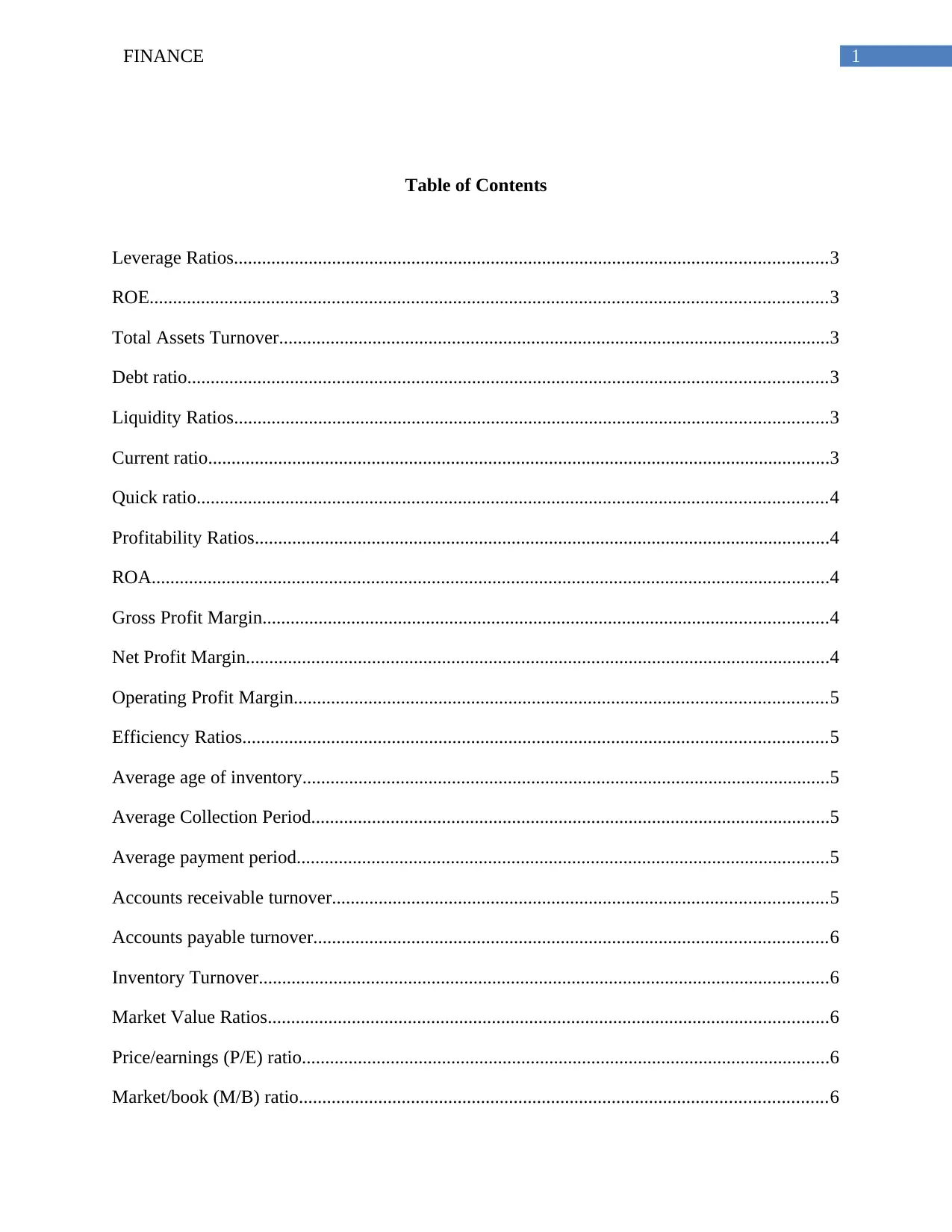
1FINANCE
Table of Contents
Leverage Ratios...............................................................................................................................3
ROE.................................................................................................................................................3
Total Assets Turnover......................................................................................................................3
Debt ratio.........................................................................................................................................3
Liquidity Ratios...............................................................................................................................3
Current ratio.....................................................................................................................................3
Quick ratio.......................................................................................................................................4
Profitability Ratios...........................................................................................................................4
ROA.................................................................................................................................................4
Gross Profit Margin.........................................................................................................................4
Net Profit Margin.............................................................................................................................4
Operating Profit Margin..................................................................................................................5
Efficiency Ratios.............................................................................................................................5
Average age of inventory.................................................................................................................5
Average Collection Period...............................................................................................................5
Average payment period..................................................................................................................5
Accounts receivable turnover..........................................................................................................5
Accounts payable turnover..............................................................................................................6
Inventory Turnover..........................................................................................................................6
Market Value Ratios........................................................................................................................6
Price/earnings (P/E) ratio.................................................................................................................6
Market/book (M/B) ratio.................................................................................................................6
Table of Contents
Leverage Ratios...............................................................................................................................3
ROE.................................................................................................................................................3
Total Assets Turnover......................................................................................................................3
Debt ratio.........................................................................................................................................3
Liquidity Ratios...............................................................................................................................3
Current ratio.....................................................................................................................................3
Quick ratio.......................................................................................................................................4
Profitability Ratios...........................................................................................................................4
ROA.................................................................................................................................................4
Gross Profit Margin.........................................................................................................................4
Net Profit Margin.............................................................................................................................4
Operating Profit Margin..................................................................................................................5
Efficiency Ratios.............................................................................................................................5
Average age of inventory.................................................................................................................5
Average Collection Period...............................................................................................................5
Average payment period..................................................................................................................5
Accounts receivable turnover..........................................................................................................5
Accounts payable turnover..............................................................................................................6
Inventory Turnover..........................................................................................................................6
Market Value Ratios........................................................................................................................6
Price/earnings (P/E) ratio.................................................................................................................6
Market/book (M/B) ratio.................................................................................................................6

2FINANCE
Book value per share.......................................................................................................................7
EPS..................................................................................................................................................7
References........................................................................................................................................8
Book value per share.......................................................................................................................7
EPS..................................................................................................................................................7
References........................................................................................................................................8
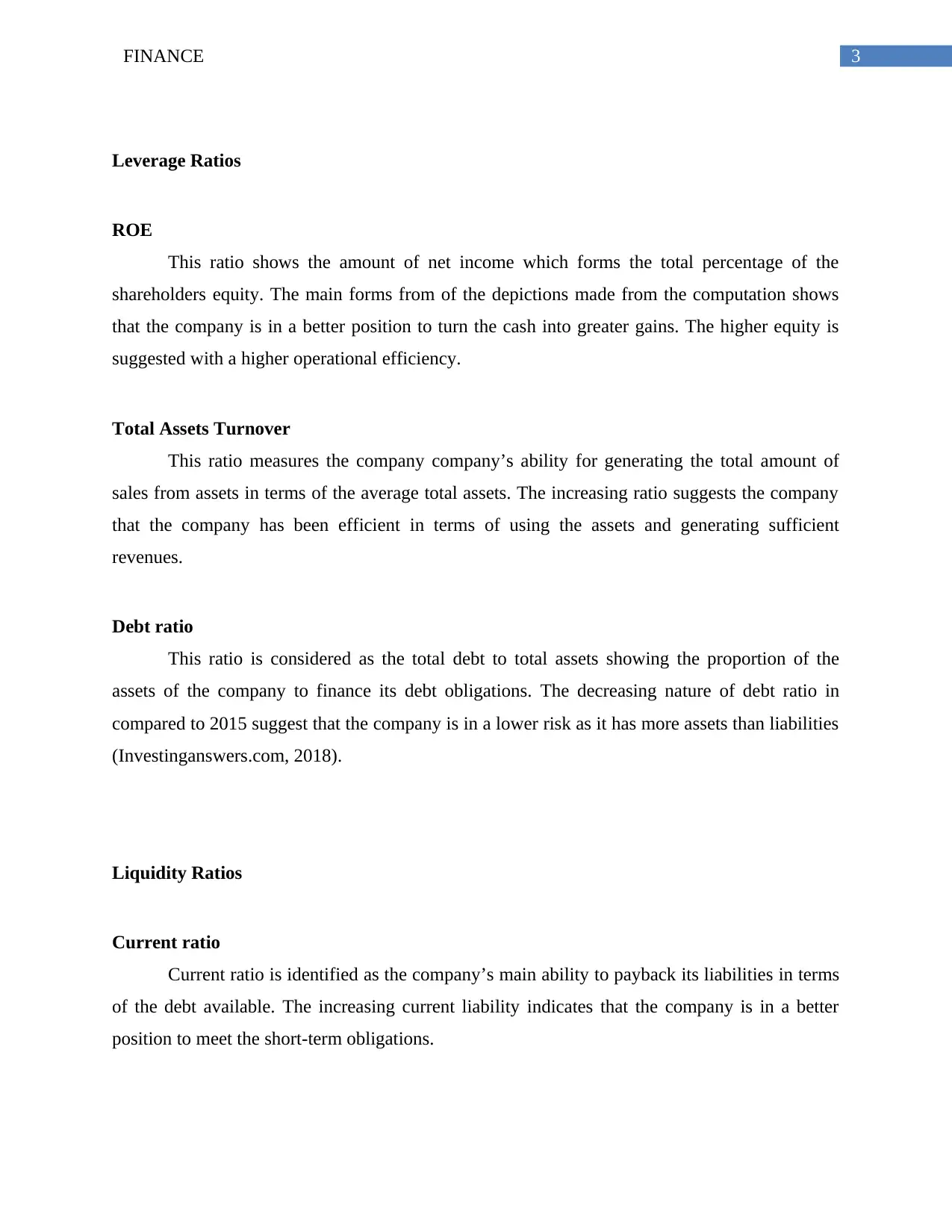
3FINANCE
Leverage Ratios
ROE
This ratio shows the amount of net income which forms the total percentage of the
shareholders equity. The main forms from of the depictions made from the computation shows
that the company is in a better position to turn the cash into greater gains. The higher equity is
suggested with a higher operational efficiency.
Total Assets Turnover
This ratio measures the company company’s ability for generating the total amount of
sales from assets in terms of the average total assets. The increasing ratio suggests the company
that the company has been efficient in terms of using the assets and generating sufficient
revenues.
Debt ratio
This ratio is considered as the total debt to total assets showing the proportion of the
assets of the company to finance its debt obligations. The decreasing nature of debt ratio in
compared to 2015 suggest that the company is in a lower risk as it has more assets than liabilities
(Investinganswers.com, 2018).
Liquidity Ratios
Current ratio
Current ratio is identified as the company’s main ability to payback its liabilities in terms
of the debt available. The increasing current liability indicates that the company is in a better
position to meet the short-term obligations.
Leverage Ratios
ROE
This ratio shows the amount of net income which forms the total percentage of the
shareholders equity. The main forms from of the depictions made from the computation shows
that the company is in a better position to turn the cash into greater gains. The higher equity is
suggested with a higher operational efficiency.
Total Assets Turnover
This ratio measures the company company’s ability for generating the total amount of
sales from assets in terms of the average total assets. The increasing ratio suggests the company
that the company has been efficient in terms of using the assets and generating sufficient
revenues.
Debt ratio
This ratio is considered as the total debt to total assets showing the proportion of the
assets of the company to finance its debt obligations. The decreasing nature of debt ratio in
compared to 2015 suggest that the company is in a lower risk as it has more assets than liabilities
(Investinganswers.com, 2018).
Liquidity Ratios
Current ratio
Current ratio is identified as the company’s main ability to payback its liabilities in terms
of the debt available. The increasing current liability indicates that the company is in a better
position to meet the short-term obligations.
Secure Best Marks with AI Grader
Need help grading? Try our AI Grader for instant feedback on your assignments.
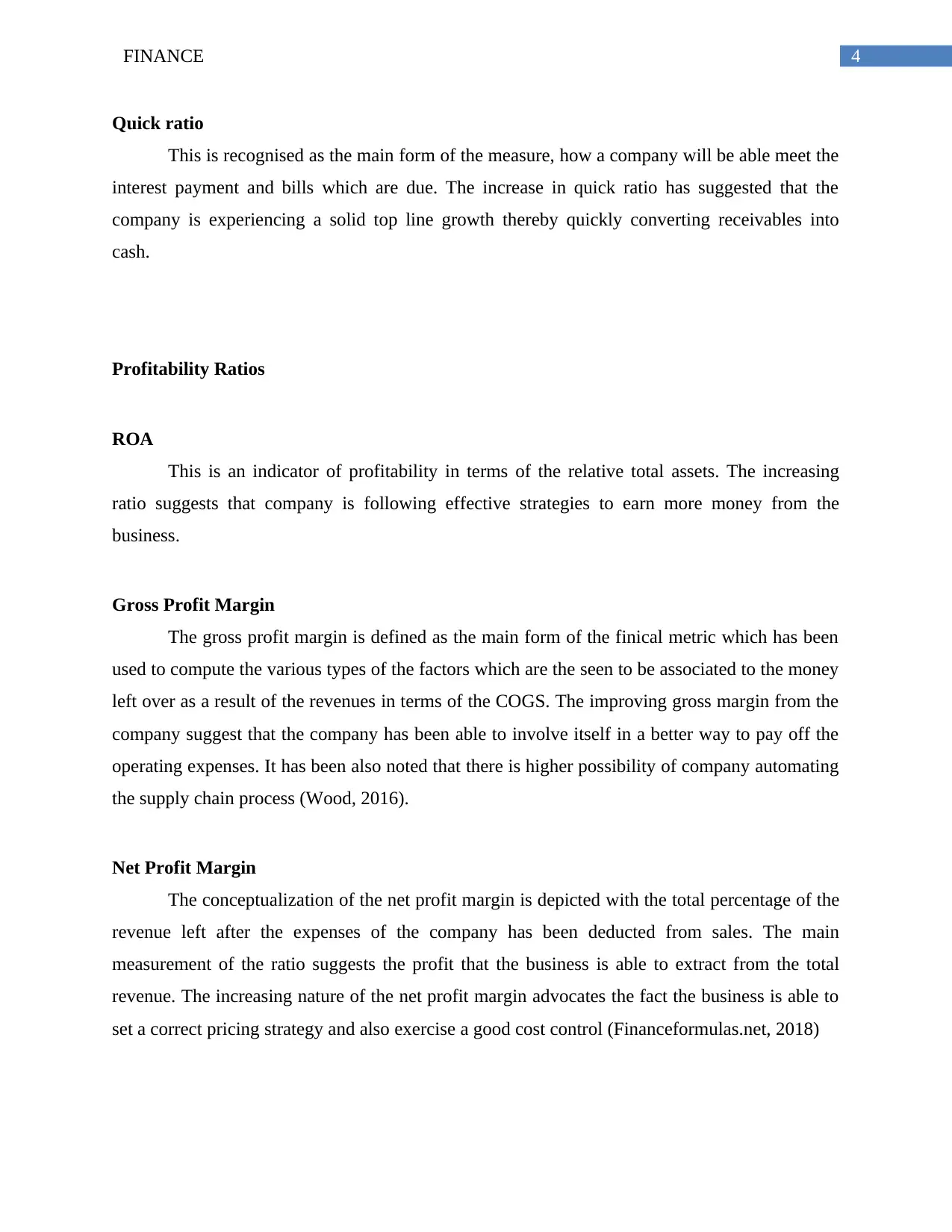
4FINANCE
Quick ratio
This is recognised as the main form of the measure, how a company will be able meet the
interest payment and bills which are due. The increase in quick ratio has suggested that the
company is experiencing a solid top line growth thereby quickly converting receivables into
cash.
Profitability Ratios
ROA
This is an indicator of profitability in terms of the relative total assets. The increasing
ratio suggests that company is following effective strategies to earn more money from the
business.
Gross Profit Margin
The gross profit margin is defined as the main form of the finical metric which has been
used to compute the various types of the factors which are the seen to be associated to the money
left over as a result of the revenues in terms of the COGS. The improving gross margin from the
company suggest that the company has been able to involve itself in a better way to pay off the
operating expenses. It has been also noted that there is higher possibility of company automating
the supply chain process (Wood, 2016).
Net Profit Margin
The conceptualization of the net profit margin is depicted with the total percentage of the
revenue left after the expenses of the company has been deducted from sales. The main
measurement of the ratio suggests the profit that the business is able to extract from the total
revenue. The increasing nature of the net profit margin advocates the fact the business is able to
set a correct pricing strategy and also exercise a good cost control (Financeformulas.net, 2018)
Quick ratio
This is recognised as the main form of the measure, how a company will be able meet the
interest payment and bills which are due. The increase in quick ratio has suggested that the
company is experiencing a solid top line growth thereby quickly converting receivables into
cash.
Profitability Ratios
ROA
This is an indicator of profitability in terms of the relative total assets. The increasing
ratio suggests that company is following effective strategies to earn more money from the
business.
Gross Profit Margin
The gross profit margin is defined as the main form of the finical metric which has been
used to compute the various types of the factors which are the seen to be associated to the money
left over as a result of the revenues in terms of the COGS. The improving gross margin from the
company suggest that the company has been able to involve itself in a better way to pay off the
operating expenses. It has been also noted that there is higher possibility of company automating
the supply chain process (Wood, 2016).
Net Profit Margin
The conceptualization of the net profit margin is depicted with the total percentage of the
revenue left after the expenses of the company has been deducted from sales. The main
measurement of the ratio suggests the profit that the business is able to extract from the total
revenue. The increasing nature of the net profit margin advocates the fact the business is able to
set a correct pricing strategy and also exercise a good cost control (Financeformulas.net, 2018)
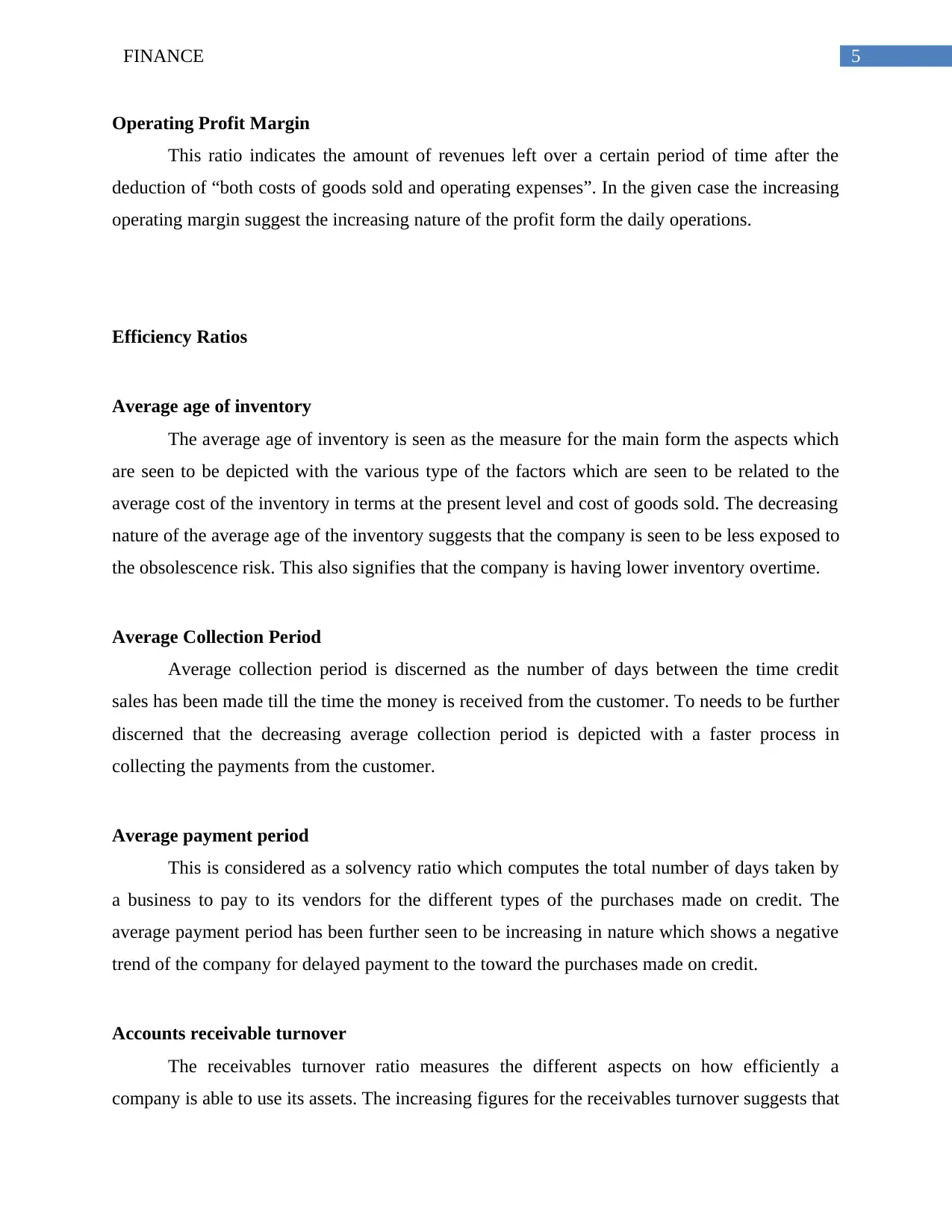
5FINANCE
Operating Profit Margin
This ratio indicates the amount of revenues left over a certain period of time after the
deduction of “both costs of goods sold and operating expenses”. In the given case the increasing
operating margin suggest the increasing nature of the profit form the daily operations.
Efficiency Ratios
Average age of inventory
The average age of inventory is seen as the measure for the main form the aspects which
are seen to be depicted with the various type of the factors which are seen to be related to the
average cost of the inventory in terms at the present level and cost of goods sold. The decreasing
nature of the average age of the inventory suggests that the company is seen to be less exposed to
the obsolescence risk. This also signifies that the company is having lower inventory overtime.
Average Collection Period
Average collection period is discerned as the number of days between the time credit
sales has been made till the time the money is received from the customer. To needs to be further
discerned that the decreasing average collection period is depicted with a faster process in
collecting the payments from the customer.
Average payment period
This is considered as a solvency ratio which computes the total number of days taken by
a business to pay to its vendors for the different types of the purchases made on credit. The
average payment period has been further seen to be increasing in nature which shows a negative
trend of the company for delayed payment to the toward the purchases made on credit.
Accounts receivable turnover
The receivables turnover ratio measures the different aspects on how efficiently a
company is able to use its assets. The increasing figures for the receivables turnover suggests that
Operating Profit Margin
This ratio indicates the amount of revenues left over a certain period of time after the
deduction of “both costs of goods sold and operating expenses”. In the given case the increasing
operating margin suggest the increasing nature of the profit form the daily operations.
Efficiency Ratios
Average age of inventory
The average age of inventory is seen as the measure for the main form the aspects which
are seen to be depicted with the various type of the factors which are seen to be related to the
average cost of the inventory in terms at the present level and cost of goods sold. The decreasing
nature of the average age of the inventory suggests that the company is seen to be less exposed to
the obsolescence risk. This also signifies that the company is having lower inventory overtime.
Average Collection Period
Average collection period is discerned as the number of days between the time credit
sales has been made till the time the money is received from the customer. To needs to be further
discerned that the decreasing average collection period is depicted with a faster process in
collecting the payments from the customer.
Average payment period
This is considered as a solvency ratio which computes the total number of days taken by
a business to pay to its vendors for the different types of the purchases made on credit. The
average payment period has been further seen to be increasing in nature which shows a negative
trend of the company for delayed payment to the toward the purchases made on credit.
Accounts receivable turnover
The receivables turnover ratio measures the different aspects on how efficiently a
company is able to use its assets. The increasing figures for the receivables turnover suggests that
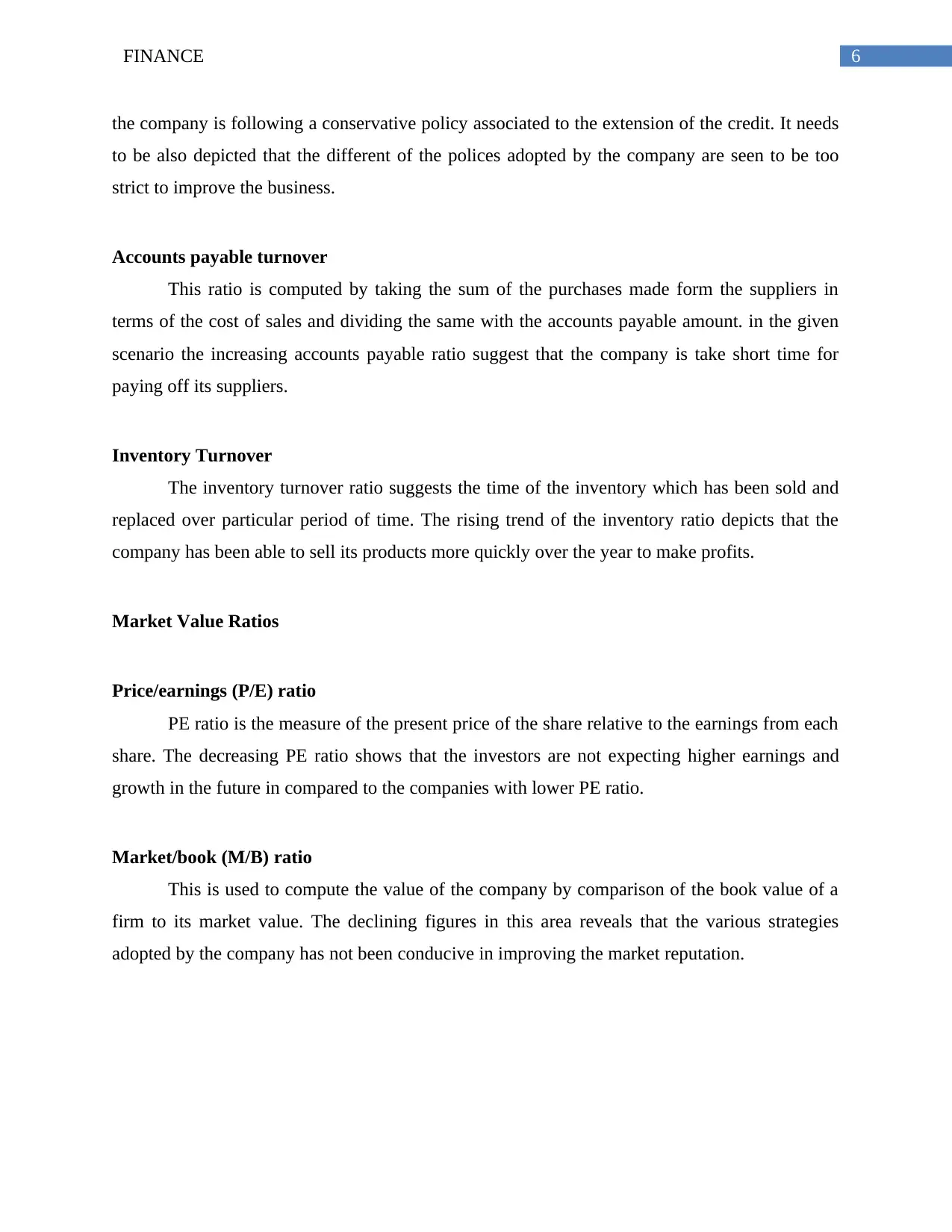
6FINANCE
the company is following a conservative policy associated to the extension of the credit. It needs
to be also depicted that the different of the polices adopted by the company are seen to be too
strict to improve the business.
Accounts payable turnover
This ratio is computed by taking the sum of the purchases made form the suppliers in
terms of the cost of sales and dividing the same with the accounts payable amount. in the given
scenario the increasing accounts payable ratio suggest that the company is take short time for
paying off its suppliers.
Inventory Turnover
The inventory turnover ratio suggests the time of the inventory which has been sold and
replaced over particular period of time. The rising trend of the inventory ratio depicts that the
company has been able to sell its products more quickly over the year to make profits.
Market Value Ratios
Price/earnings (P/E) ratio
PE ratio is the measure of the present price of the share relative to the earnings from each
share. The decreasing PE ratio shows that the investors are not expecting higher earnings and
growth in the future in compared to the companies with lower PE ratio.
Market/book (M/B) ratio
This is used to compute the value of the company by comparison of the book value of a
firm to its market value. The declining figures in this area reveals that the various strategies
adopted by the company has not been conducive in improving the market reputation.
the company is following a conservative policy associated to the extension of the credit. It needs
to be also depicted that the different of the polices adopted by the company are seen to be too
strict to improve the business.
Accounts payable turnover
This ratio is computed by taking the sum of the purchases made form the suppliers in
terms of the cost of sales and dividing the same with the accounts payable amount. in the given
scenario the increasing accounts payable ratio suggest that the company is take short time for
paying off its suppliers.
Inventory Turnover
The inventory turnover ratio suggests the time of the inventory which has been sold and
replaced over particular period of time. The rising trend of the inventory ratio depicts that the
company has been able to sell its products more quickly over the year to make profits.
Market Value Ratios
Price/earnings (P/E) ratio
PE ratio is the measure of the present price of the share relative to the earnings from each
share. The decreasing PE ratio shows that the investors are not expecting higher earnings and
growth in the future in compared to the companies with lower PE ratio.
Market/book (M/B) ratio
This is used to compute the value of the company by comparison of the book value of a
firm to its market value. The declining figures in this area reveals that the various strategies
adopted by the company has not been conducive in improving the market reputation.
Paraphrase This Document
Need a fresh take? Get an instant paraphrase of this document with our AI Paraphraser
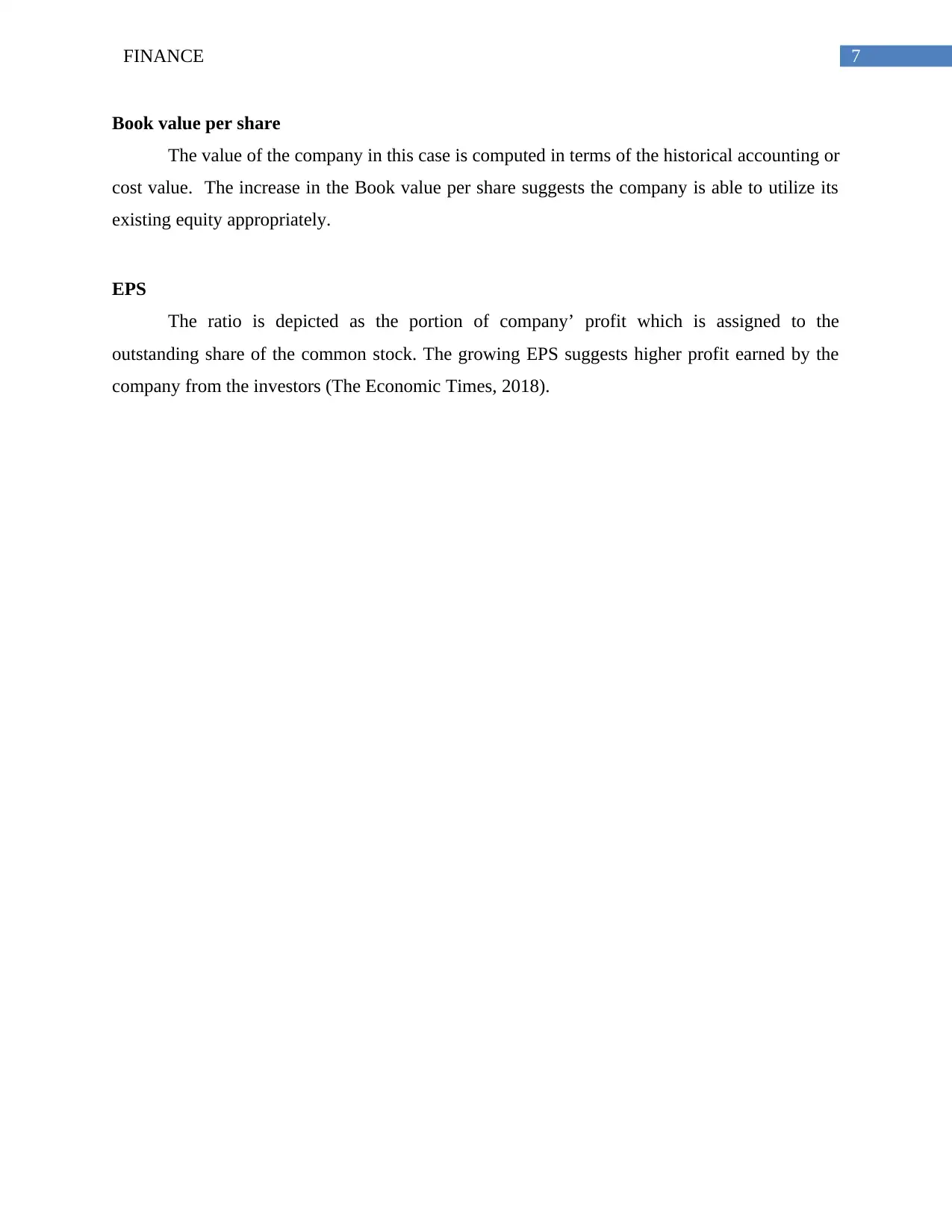
7FINANCE
Book value per share
The value of the company in this case is computed in terms of the historical accounting or
cost value. The increase in the Book value per share suggests the company is able to utilize its
existing equity appropriately.
EPS
The ratio is depicted as the portion of company’ profit which is assigned to the
outstanding share of the common stock. The growing EPS suggests higher profit earned by the
company from the investors (The Economic Times, 2018).
Book value per share
The value of the company in this case is computed in terms of the historical accounting or
cost value. The increase in the Book value per share suggests the company is able to utilize its
existing equity appropriately.
EPS
The ratio is depicted as the portion of company’ profit which is assigned to the
outstanding share of the common stock. The growing EPS suggests higher profit earned by the
company from the investors (The Economic Times, 2018).
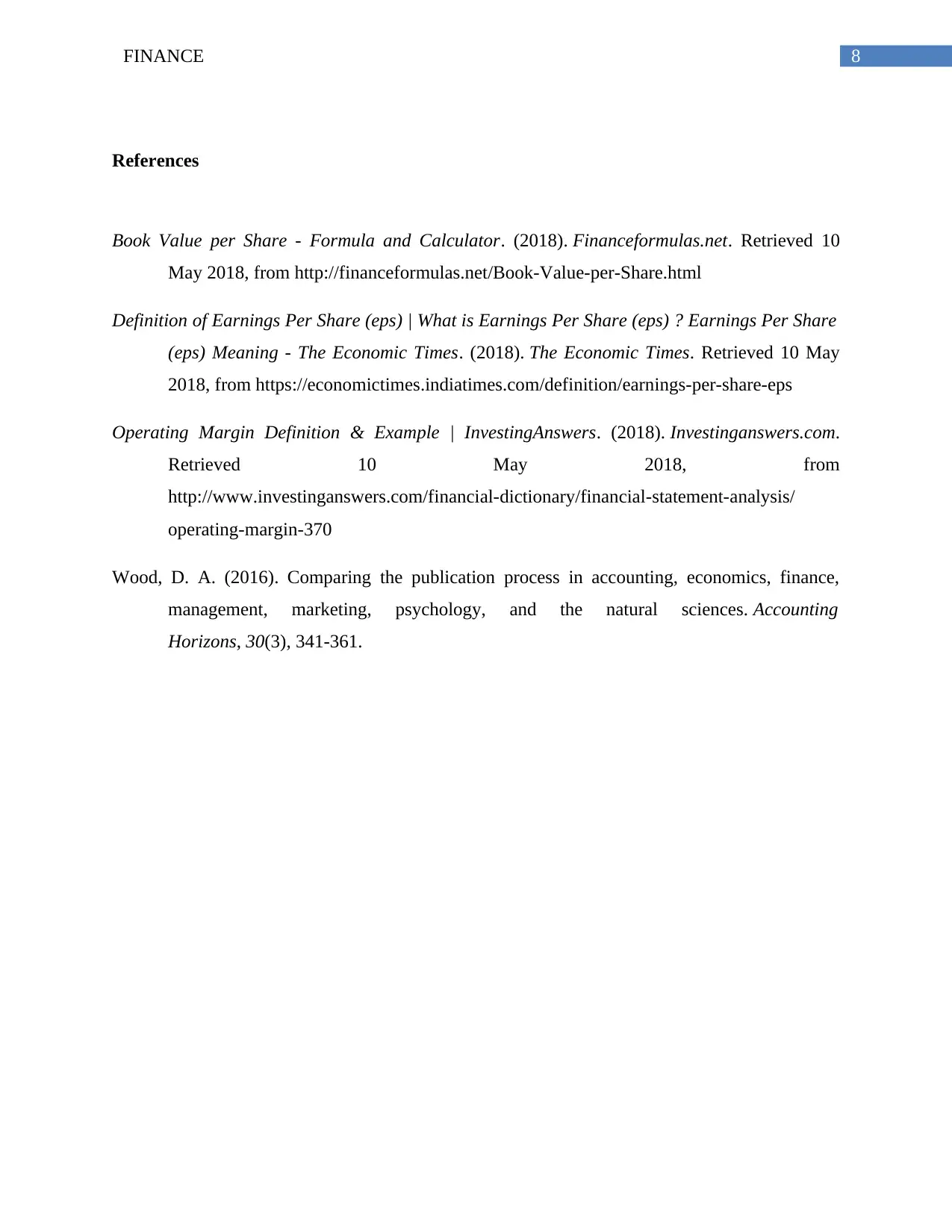
8FINANCE
References
Book Value per Share - Formula and Calculator. (2018). Financeformulas.net. Retrieved 10
May 2018, from http://financeformulas.net/Book-Value-per-Share.html
Definition of Earnings Per Share (eps) | What is Earnings Per Share (eps) ? Earnings Per Share
(eps) Meaning - The Economic Times. (2018). The Economic Times. Retrieved 10 May
2018, from https://economictimes.indiatimes.com/definition/earnings-per-share-eps
Operating Margin Definition & Example | InvestingAnswers. (2018). Investinganswers.com.
Retrieved 10 May 2018, from
http://www.investinganswers.com/financial-dictionary/financial-statement-analysis/
operating-margin-370
Wood, D. A. (2016). Comparing the publication process in accounting, economics, finance,
management, marketing, psychology, and the natural sciences. Accounting
Horizons, 30(3), 341-361.
References
Book Value per Share - Formula and Calculator. (2018). Financeformulas.net. Retrieved 10
May 2018, from http://financeformulas.net/Book-Value-per-Share.html
Definition of Earnings Per Share (eps) | What is Earnings Per Share (eps) ? Earnings Per Share
(eps) Meaning - The Economic Times. (2018). The Economic Times. Retrieved 10 May
2018, from https://economictimes.indiatimes.com/definition/earnings-per-share-eps
Operating Margin Definition & Example | InvestingAnswers. (2018). Investinganswers.com.
Retrieved 10 May 2018, from
http://www.investinganswers.com/financial-dictionary/financial-statement-analysis/
operating-margin-370
Wood, D. A. (2016). Comparing the publication process in accounting, economics, finance,
management, marketing, psychology, and the natural sciences. Accounting
Horizons, 30(3), 341-361.
1 out of 9
Related Documents
Your All-in-One AI-Powered Toolkit for Academic Success.
+13062052269
info@desklib.com
Available 24*7 on WhatsApp / Email
![[object Object]](/_next/static/media/star-bottom.7253800d.svg)
Unlock your academic potential
© 2024 | Zucol Services PVT LTD | All rights reserved.





